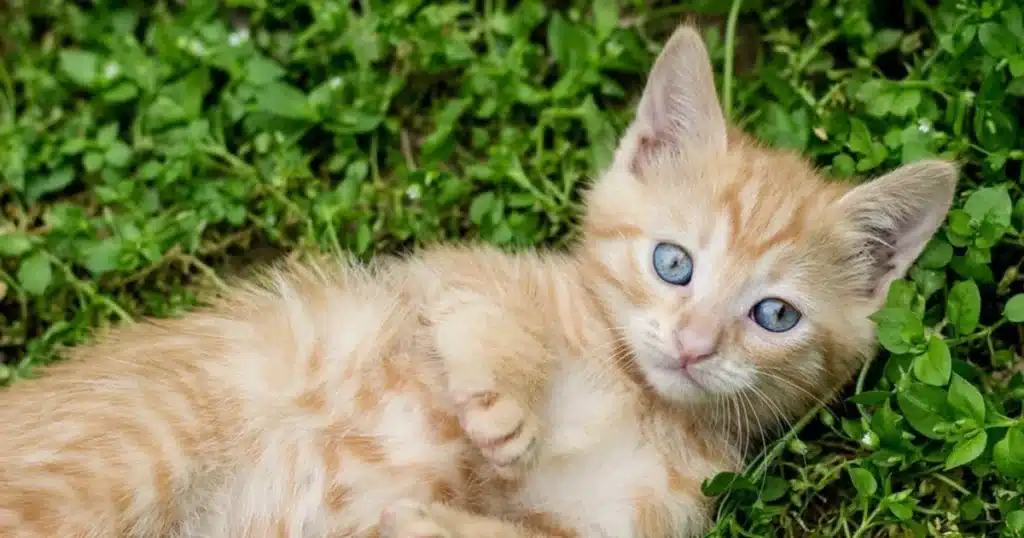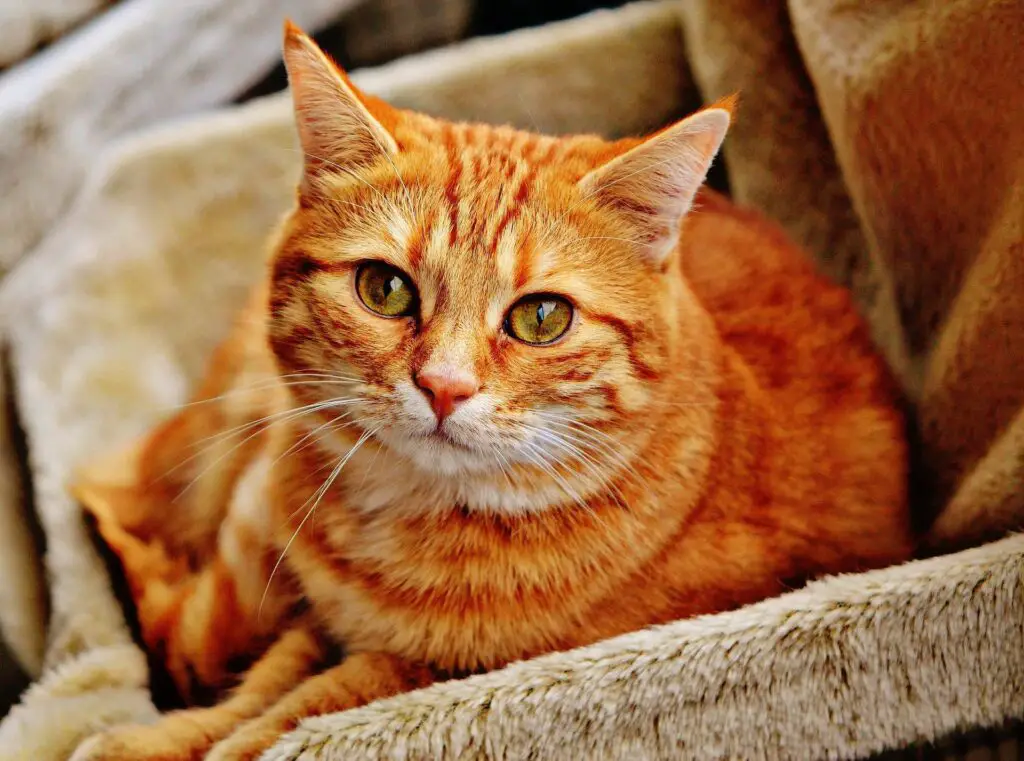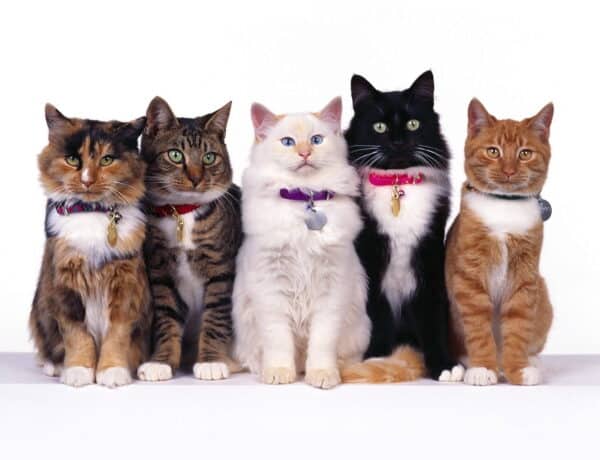Introduction
Can Orange Cats Be Female: Orange cats are a popular choice among pet owners due to their vibrant and eye-catching fur color. However, there is a common misconception that orange cats can only be male. In reality, orange cats can be both male and female, although the percentage of female orange cats is significantly lower than males. The genetics behind orange cats and shed light on the factors that determine their gender.
Orange cats, also known as ginger or marmalade cat cold, are a result of a specific gene called the “”O”” gene. This gene is responsible for the production of orange pigment in the fur. The O gene is located on the X chromosome, which means that it is sex-linked. Male cats have one X and one Y chromosome, while females have two X chromosomes. As a result, the inheritance of the O gene differs between males and females.
Male orange cats only need one copy of the O gene to display the orange fur color. This is because they have only one X chromosome, and if it carries the O gene, it will be expressed. On the other hand, female orange cats need two copies of the O gene, one on each X chromosome, to exhibit the orange fur color. This is why female orange cats are less common than males, as they require both parents to carry the O gene.
Cats are solid orange. Some may have white patches or other coat patterns, which are determined by additional genes. The presence of these genes can further complicate the inheritance of the orange fur color. The intensity of the orange color can vary among individual cats, ranging from a pale apricot to a deep reddish-orange.

How rare is a female orange cat?
This is because the gene that causes a cat to be orange is linked to sex, and statistically most orange cats are boys. Only about 1 in 5 orange cats are female, so if you have an orange girl cat, consider yourself blessed with an extra special pet!
Female orange cats are considered to be quite rare. While orange cats are more commonly male, accounting for about 80% of all orange cats, female orange cats make up the remaining 20%. This makes them a minority within the orange cat population, and their rarity adds to their appeal and desirability as pets.
The reason behind the rarity of female orange cats lies in their genetics. The gene responsible for the orange coat color is located on the X chromosome. Since males have one X and one Y chromosome, they only need to inherit the orange gene from their mother to display the orange coat color. On the other hand, females have two X chromosomes, and both need to carry the orange gene for the cat to be orange. If only one X chromosome carries the orange gene, the cat will have a tortoiseshell or calico coat pattern instead.
Due to this genetic inheritance, female orange cats are less common than their male counterparts. The occurrence of a female orange cat requires both parents to carry the orange gene and pass it on to their offspring. This combination of genetic factors makes female orange cats a rarity in the feline world.
Despite their rarity, female orange cats are just as lovable and affectionate as any other cat. Their unique coat color adds to their charm and makes them stand out from the crowd. Whether male or female, orange cats are known for their friendly and outgoing personalities, making them wonderful companions for any cat lover.
Can female cats be fully orange?
For female cats to be orange, they need the B gene on both X chromosomes. However, since there are so many possible chromosome combinations, females are less likely to be orange. Meanwhile, males only need red, calico, or tortoiseshell mothers.
Yes, female cats can indeed be fully orange. While it is more common for male cats to have orange fur, female cats can also exhibit this coloration. The orange color in cats is caused by a gene called the “”O”” gene, which is responsible for producing the pigment called pheomelanin. This pigment gives the fur its orange hue. Both male and female cats can carry this gene, but it is more frequently expressed in males.
The expression of the orange color in cats is influenced by other genes as well. For example, the presence of the “”O”” gene alone does not guarantee that a cat will have fully orange fur. Other genes, such as those responsible for tabby patterns or dilution of color, can also affect the appearance of the fur. This is why you may see variations in the shade or pattern of orange in female cats.
The orange color in cats can vary in intensity. Some cats may have a vibrant, deep orange color, while others may have a lighter, more diluted shade. This variation is influenced by genetic factors and can be seen in both male and female cats.
It is also worth mentioning that the orange color in cats is not limited to a specific breed. Cats of various breeds, including domestic shorthairs, Maine Coons, and Persians, can all have orange fur. Therefore, if you come across a female cat with fully orange fur, it is not necessarily indicative of a specific breed.
How can you tell if an orange cat is a female?
Look for genitalia characteristic of a female cat.
- A female cat will have an anus and a urinary tract opening/vulva, with the vulva in the shape of a vertical slit.
- A female cat will have a shorter distance between anus and vulva, typically about 1⁄2 inch (1.3 cm) apart.
An orange cat is a type of cat that has a distinct orange fur color. It is not a specific breed, but rather a color variation that can be found in various cat breeds. When it comes to determining the gender of an orange cat, there are a few physical and behavioral characteristics that can help you determine if it is a female.
Physical characteristics: One way to tell if an orange cat is a female is by looking at its physical characteristics. Female cats have certain anatomical features that are different from males. One of the most obvious differences is the presence of nipples. Female cats have nipples, which are located on their abdomen. These nipples are used for nursing their kittens. Another physical characteristic that can help determine the gender of an orange cat is the distance between the anus and the genital opening. In female cats, the distance between these two openings is shorter compared to males.
Behavioral characteristics: In addition to physical characteristics, the behavior of an orange cat can also provide clues about its gender. Female cats tend to be more territorial and may exhibit behaviors such as spraying urine to mark their territory. They may also be more vocal, especially when they are in heat. Male cats, on the other hand, are more likely to roam and exhibit behaviors such as spraying urine to mark their territory.
Genetic testing: If you are still unsure about the gender of an orange cat, you can consider genetic testing. This involves taking a DNA sample from the cat and sending it to a laboratory for analysis. The laboratory will then determine the cat’s gender based on its genetic makeup. Genetic testing is a more accurate method of determining the gender of a cat, but it is also more expensive and time-consuming.
What color cat can only be female?
Calico cats
Calico cats are almost always female because the locus of the gene for the orange/non-orange coloring is on the X chromosome.
The color of a cat does not determine its gender. The idea that a certain color of cat can only be female is a common misconception. In reality, the color of a cat’s fur is determined by its genetics, specifically the genes responsible for coat color. These genes can be inherited from both the mother and the father, and they can result in a wide variety of coat colors and patterns.
One popular belief is that calico cats, which have a coat of three colors – usually black, orange, and white – are always female. While it is true that the majority of calico cats are female, there are rare cases where male calico cats exist. These male calico cats are typically sterile, meaning they cannot reproduce, and they are the result of a genetic abnormality.
Another misconception is that all white cats are female. This belief likely stems from the fact that white cats are often associated with purity and femininity. However, white cats can be either male or female, just like cats of any other color. The color of a cat’s fur has no bearing on its gender.
Is determined by the cat’s reproductive organs, not its coat color. Male cats have testes and can sire kittens, while female cats have ovaries and can give birth to kittens. The color of a cat’s fur is simply a physical characteristic that has no connection to its gender.
What is the rarest color of a cat?
Of all the cats we discussed, the true albino cat is the rarest. These cats will have an all-white coat with blue eyes. The non-albino white cat is the next rarest, followed by other cats with white fur due to albinism, or the gene that prevents color from reaching the skin.
The rarest color of a cat is often considered to be the color white. While white cats may not be as common as cats with other coat colors, they are highly sought after by many cat lovers. White cats are known for their striking appearance and unique charm.
One reason why white cats are considered rare is because they often have a genetic condition called deafness. It is estimated that about 60-80% of white cats with blue eyes are deaf in one or both ears. This is due to a gene that is responsible for both the white coat color and the development of the inner ear. While this condition may be a disadvantage for the cat, it also adds to their rarity and makes them even more special to those who appreciate their unique characteristics.
Another reason why white cats are considered rare is because the gene that produces the white coat color is recessive. This means that both parents must carry the gene in order for their offspring to have a white coat. If only one parent carries the gene, the offspring will have a different coat color. This makes white cats less common compared to cats with other coat colors, such as black, brown, or tabby.
White cats also have a long history of being associated with superstitions and folklore. In many cultures, white cats are believed to bring good luck and prosperity. They are often seen as symbols of purity and innocence. This adds to their allure and makes them even more desirable to cat enthusiasts.
The rarest color of a cat is often considered to be white. White cats are unique and special due to their striking appearance, genetic condition of deafness, recessive gene for the white coat color, and their association with superstitions and folklore. While they may not be as common as cats with other coat colors, white cats are highly sought after and cherished by many cat lovers.
Orange cats, as the name suggests, have a coat color that is predominantly orange. This color can vary in shade, ranging from a light, almost cream-like orange to a deep, vibrant reddish-orange. The color of an orange cat’s fur is determined by a specific gene called the “”O gene,”” which is responsible for producing the pigment that gives their coat its distinctive hue.
While orange is the primary color of their fur, orange cats can also have other markings or patterns. These can include tabby stripes, spots, or even patches of white. The combination of orange with these additional markings creates a unique and visually appealing appearance.
Can female cats have orange fur?
Yes, female cats can indeed have orange fur. While it is true that orange cats are more commonly male, female cats can also carry the gene responsible for orange fur. The gene that determines the color of a cat’s coat is located on the X chromosome, and since female cats have two X chromosomes, they have a higher chance of inheriting the orange gene.
However, The presence of the orange gene in female cats does not guarantee that they will have orange fur. The expression of the gene can be influenced by other genetic factors, resulting in variations in coat color. So, while less common, it is definitely possible for female cats to have beautiful orange fur.
Can female cats have orange fur?
Yes, female cats can indeed have orange fur. While it is more common for male cats to have orange fur, female cats can also possess this coloration. The gene responsible for orange fur is carried on the X chromosome, and since female cats have two X chromosomes, they have a higher chance of inheriting the orange fur gene.
All female cats with orange fur are purebred. In some cases, female cats with orange fur may be calico or tortoiseshell cats, which have a combination of orange, black, and white fur. These cats have a unique genetic makeup that allows for the expression of different coat colors.
Are all orange cats male?
No, not all orange cats are male. While it is true that the majority of orange cats are male, there are also female cats that can have orange fur. The reason behind this gender color preference lies in genetics.
Orange fur in cats is linked to the X chromosome. Male cats have one X and one Y chromosome, while female cats have two X chromosomes. The gene responsible for orange fur is located on the X chromosome. Since males only have one X chromosome, if it carries the orange gene, they will have orange fur. On the other hand, females need to inherit the orange gene from both of their X chromosomes to have orange fur.
However, there is a phenomenon called calico or tortoiseshell cats, which are predominantly female and can have patches of orange fur. This is because calico cats have two X chromosomes and one of them carries the orange gene. The other X chromosome may carry a different gene, resulting in patches of different colors, including orange.
Is it possible for a female cat to be orange?
Yes, it is definitely possible for a female cat to be orange. While it is true that orange cats are more commonly male, female cats can also have orange fur. The gene responsible for orange fur is carried on the X chromosome, and since female cats have two X chromosomes, they have a higher chance of inheriting the orange gene.
However, the presence of orange fur in female cats is not as common as in males. This is because another gene, called the sex-linked gene, can suppress the expression of the orange gene in female cats. As a result, female cats with orange fur are relatively rare compared to their male counterparts.
So, if you come across a female cat with orange fur, consider yourself lucky! It is a unique and special trait that adds to the beauty and diversity of the feline world.
Do female cats commonly have orange fur?
Female cats can have a variety of fur colors, including orange. While it is true that orange fur is more commonly seen in male cats, it is not exclusive to them. The gene responsible for orange fur is carried on the X chromosome, and since female cats have two X chromosomes, they have a higher chance of inheriting the gene. However, the presence of other genes can influence the expression of the orange fur gene, resulting in a wide range of coat colors in female cats.
The frequency of orange fur in female cats can vary depending on the breed and individual genetics. Some breeds, such as the Maine Coon and Abyssinian, are more likely to have female cats with orange fur. Certain coat patterns, such as tortoiseshell and calico, often include patches of orange fur in female cats.
Overall, while orange fur may be more commonly associated with male cats, it is not uncommon for female cats to have this coloration. The genetics behind fur color in cats are complex, and various factors can influence the expression of specific genes. So, if you come across a female cat with orange fur, it is simply a result of the unique combination of genes she inherited.

Conclusion
The color of a cat’s fur, including orange, is determined by genetics and can be found in both male and female cats. While orange cats are more commonly associated with males due to the presence of the orange gene on the X chromosome, female cats can also inherit this gene and display orange fur. The presence of the orange gene in female cats is dependent on various factors, including the combination of genes inherited from both parents.
It is also worth mentioning that the orange cat gene can be masked by other genes, resulting in cats with different coat colors. This explains why not all orange cats are purely orange, as they can have variations such as tabby patterns or white markings. The intensity of the orange color can vary among individual cats, with some displaying a vibrant shade while others have a more muted tone.
The orange gene is not the only factor that determines a cat’s gender. The sex of a cat is determined by the presence of sex chromosomes, with males having one X and one Y chromosome (XY) and females having two X chromosomes (XX). Therefore, the color of a cat’s fur does not dictate its gender, and female cats can indeed have orange fur.
While orange cats are commonly associated with males, female cats can also have orange fur. The presence of the orange gene in female cats is determined by genetics and can be influenced by various factors. It is important to consider the combination of genes inherited from both parents and the potential masking of the orange gene by other genes. Ultimately, the color of a cat’s fur does not determine its gender, as this is determined by the presence of sex chromosomes.





No Comments